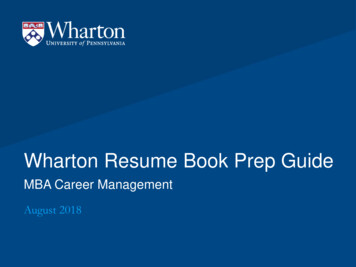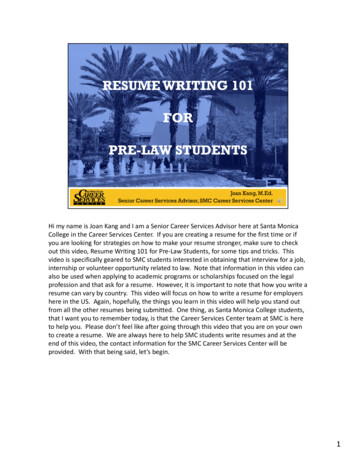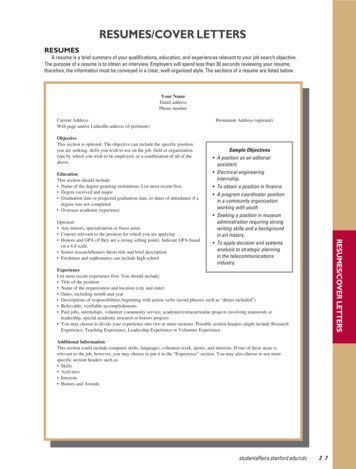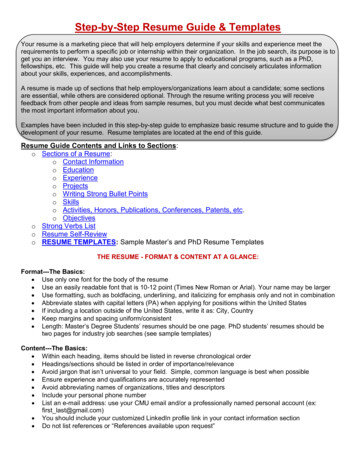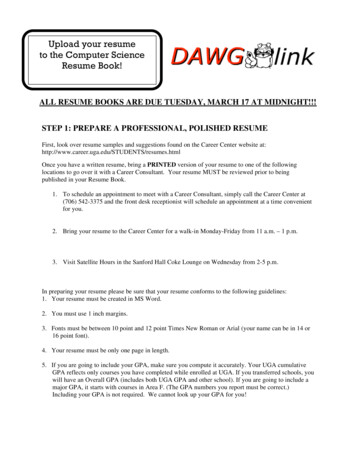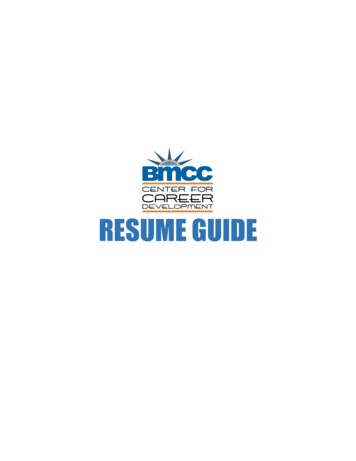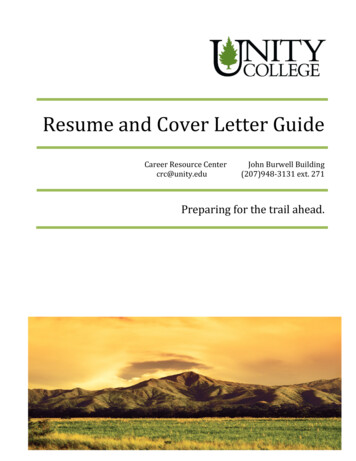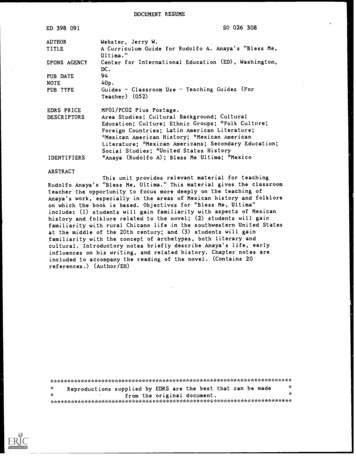
Transcription
DOCUMENT RESUMESO 026 308ED 398 091AUTHORTITLESPONS AGENCYWebster, Jerry W.A Curriculum Guide for Rudolfo A. Anaya's "Bless Me,Ultima."Center for International Education (ED), Washington,DC.PUB DATENOTEPUB TYPE9440p.Classroom UseGuidesTeacher) (052)EDRS PRICEDESCRIPTORSMF01/PCO2 Plus Postage.Area Studies; Cultural Background; CulturalEducation; Culture; Ethnic Groups; *Folk Culture;Foreign Countries; Latin American Literature;*Mexican American History; *Mexican AmericanLiterature; *Mexican Americans; Secondary Education;Social Studies; *United States History*Anaya (Rudolfo A); Bless Me Ultima; *MexicoIDENTIFIERSTeaching Guides (ForABSTRACTThis unit provides relevant material for teachingRudolfo Anaya's "Bless Me, Ultima." This material gives the classroomteacher the opportunity to focus more deeply on the teaching ofAnaya's work, especially in the areas of Mexican history and folkloreon which the book is based. Objectives for "Bless Me, Ultima"include: (1) students will gain familiarity with aspects of Mexicanhistory and folklore related to the novel; (2) students will gainfamiliarity with rural Chicano life in the southwestern United Statesat the middle of the 20th century; and (3) students will gainfamiliarity with the concept of archetypes, both literary andcultural. Introductory notes briefly describe Anaya's life, earlyinfluences on his writing, and related history. Chapter notes areincluded to accompany the reading of the novel. (Contains 20references.) ********************************Reproductions supplied by EDRS are the best that can be madefrom the original ******************************
A Curriculum Guide forRudolfo A. Anaya's Bless Me. Ultimaby Jerry W. Websterr\r-,1994 Fulbright-Hays Seminar Abroad Program: MexicoPERMISSION TO REPRODUCE ANDDISSEMINATE THIS MATERIALH,AS BEEN GRANTED BYlio5o 11, e6EN b/141-6/v/e6TO THE EDUCATIONAL RESOURCESINFORMATION CENTER (ERIC)BEST COPY AVABABLEU S DEPARTMENT OF EDUCATIONr iitr 0 . f .5, ai c.-.1 ii,,eatch nnei,rvevementEDUCATIONAL RESOURCES INFORMATIONCENTER (ERIC)This doc ument has boon reproduced asreceived from the person or organint- onXoriginating it0 Minor changes have been made toimprove roproduction qualityPoints of view or opinionsslated in thisdocument do not nocessanly representolficial OEM position or policy
This unit grew out of my experience as a 1994 Fulbright-HaysSummer Seminar participant to Mexico. The purpose of this unit is toprovide relevant teaching material for the classroom instruction ofRudolfo Anaya's Bless Me. Ultima. This material should allow theclassroom teacher to go more deeply into the teaching of Anaya's work,especially in the areas of Mexican history and folklore on which this bookis based.Student Objectives for Bless Me. Ultima1.Students will gain familiarity with aspects of Mexican history andfolklore related to the novel.2.Students will gain familiarity with rural Chicano life in thesouthwestern United States at the middle of the twentieth century.3.Students will gain familiarity with the concept of archetypes, bothliterary and cultural.,
Anaya's LifeAnaya's family had first settled in Albuquerque with a Mexican landgrant.The family then moved with the first families that went westwardinto the plains of New Mexico when it was initially safe to do so, aroundthe middle of the nineteenth century.His parents met in the small townof Puerto de Luna. Rudolfo Anaya was born in 1937, in Pastura, a smallvillage on the plains of New Mexico where ranching was the commonlivelihood of this rural area.Soon after Rudolfo was born, Anaya's famliy moved to Santa Rosa onHighway 66.Being on a major highway opened Anaya to more cosmopolitaninfluences than his previous environment.Santa Rosa provides thebackground setting for Bless Me. Ultima (Bruce-Novoa 185).Anaya's father and mother spoke Spanish, and Anaya was brought upin an almost completely Hispanic environment.elementary school.However, this changed inAnaya's lessons were in English. Although Anaya is aleading Chicano writer, his books are written in English as this is thelanguage with which Anaya feels most comfortable and most fluent(189).Bless Me. Ultima was Anaya's first work and won Anaya immediateacclaim.He has since published a succession of works.Recurrent themesinclude his study of Mexican folklore, his upbringing in New Mexico, and
the fight of Chicano survival in Anglo-American society.Anaya completed both his graduate and undergraduate work at theUniversity of New Mexico.He is currently a professor at the sameuniversity, teaching creative writing and Chicano literature classes.
Early Influences en Anaya's WritingAnaya's writing draws heavily on his New Mexican heritage.This isespecially true of Bless Me. Ultima which is based upon Mexican folklore.On the connection between his writing and his background, Anaya has said,".my interest in writing is to explore the magic in realism and in thatsense of my immediate environment and my relationship to my region isonly a point of reference, but a very important place because it is the'taking off point.'It is the place where imagination and the image-ladenmemory begin their work, and the three forces--place, imagination, andare inextricably bound together in my work"memory(Anaya 1977, 39).Among the early people of Anaya's youth, there were ".ancianos whotaught me to respond to my landscape and to acquire the harmony that isinherent between man and his place" (40).An affinity not only for the land but also for the people of Anaya'sheritage permeates Anaya's work.Of his early days, Anaya says, "Anytime that people gathered, family or friends, they told stories, cuentostales), anecdotes, dichos (sayings), advinzanos (riddles)"188).Itis this rich oral tradition that forms the base for(Bruce-NovoaBia%,9 16.2 ,Ultima with its tales of curanderas and brujas, magic and witchcraft.
Related HistoryThe early civilizations of Mexico, civilizations that rivaled Rome inits grandeur, have left mainlyto their disappearance.pyramids and ruins behind with few cluesLater cultures, such as the Mayan and the Aztec,also founded great empires. The Aztqcs came to Mexico in the 1160's, andslowly expanded their power and territory.The Aztecs ruled most ofMexico until 1519 brought the arrival of the Spanish conquistadors led byHernando Cortez. The Spaniards called the land Nueva Espana and forcedmany of the Indians to convert to the Roman Catholic faith.The descendents of these Spanish explorers and the nativeAmericans are the ancestors of today's Chicanos. In 1598, Juan de Onateled 130 families and a large herd of livestock from Nueva Espana to anarea they named "New Mexico." He was of Spanish descent and claimed theland for Spain.His wife was the great-granddaughter of Montezuma, theking killed by Cortez 'during the time of the Spanish conquest.In 1810, the people of New Mexico revolted against Spain, and in1821, the revolutionists set up the independent nation of Mexico.In1846-1848, there was a war between the United States and Mexico. Asthe eventual victors, the United States took all of northern Mexico,including the area known as New Mexico.
At first this area consisted largely of farms and ranches. Then camelumbering and mining.Eventually, factories appeared, and many peoplemoved to large cities to find work, having found it more and more difficultto make a livelihood off the land (Literacy Volunteers 12-14).It is this background that forms the setting to Bless Me. Ultima. TheAnaya family struggles to survive- in its present environment.must keep pace with the changing times.well aware of its cultural heritage.and enriches their lives.The familyAt the same time the family isThis awareness continually informs
777.17.777.77-'77.77T7'7.-1',75mT,7-Notes on ChaptersChapters will have explanatory notes that may assist the teacherpresenting the chapters. There are also class work activities included.UnoIn the first paragraph, the narrator presents Uitima as the one whoallowed ".the beauty of the Ilano to be presented before my eyes.thepulse of the living earth pressed its mystery into my living blood.Timestood still, and it shared with me all that had been, and all that was tocome." (1). The reader is immediately aware of Ultima's overwhelmingpresence for the boy narrator. This same power has been attributed toUltima by Anaya from his own experience. The author had been strugglingfor several years with this book. Then one night, he says, ".I heard anoise and turned to see an old woman dressed in black enter the room.This is how Ultima came to me, deep in the process of creativity; while Iwas struggling with the story. Old and bent, the fragrance of sweet . herbsclinging to her dress, wrinkled but with the fire of truth and wisdcmburning in her eyes, she moved towards me. Que' hace hijo? the old womanasked.Her presence in the room was strong, palpable. She laid her hand onmy shoulder and I felt the power of the worldwind" (Jacobsen 4). Theauthor's description seems little different from that of the boy's. Theauthor has the boy again mention this magical experience later in the firstchapter, "The four directions of the Ilano met in me, and the white sunshone on my soul" (10).1.In the third paragraph it becomes clear that the narrator is retellingthese events from his early childhood at a later point in his life althoughthe exact time is not specified.2.The boy's father had been a vaquero, or cowboy. The narrator identifiesthis with "a callin9 as deep as the coming of the Spaniard to Nuevokgjico." The Márezes, the father's family, are linked back to the3.conquistadors.The father's spirit is a wild spirit, where "the spirit of thehorse was very close to the spirit of the man." (2).Mexicans typically place high value on the family and family solidarity.When the mother is worried that Ultima will live her last days inloneliness, the father says ".it is not the way of our people (3). Later, the4.
narrator comments, "There was always room in the safety and warmth ofla familia for one more person." (4). The emphasis on strong familysolidarity is maintained throughout the book.Ultima is a curandera, "a woman who knew the herbs and remedies ofthe ancients." (4). Opposed to her are the brujas, or witches, who makepeople ill. Antonio, the boy narrator, remarks, "The cuentos of the peoplewere full of tales of evil done by brujas" (4). The narrator is immersed ina deep oral tradition in which tales about white and black magic arecommonplace and remain a common mythology of today.5.Italics demonstrate dream sequences in the book. In the first dream,the father's and mother's families fight over Antonio's destiny. The Luna6.family, the mother's farming family, surround the boy with fruits andvegetables and rub dirt on his head to make him of this earth. The Mdrezfamily, the father's vaquero family, replace the produce with riding gearand remove the earth so that Antonio's spirit will not be bound but wild.They say, "His forefathers were conquistadores." (6). Through this dreamAnaya presents the basic feud between the two families. The motherwants her son to become a farmer or priest. The father wants the boy tobecome a free jpirit like a vaquero. In the dream sequence, Ultima stopsthe feud between the two families and declares, "Only I will know hisdestiny" (6). Ultima is established as a protector figure for the boy. Oneinteresting point is that the boy, when questioning his mother at a laterpoint in the chapter, learns that the contents of the dream generallyoccurred in real life--that there really was such an argument between thetwo families at his birth.Anaya gives a notion of Antonio's belief in Ultima's power at the end ofchapter one. In this dream Antonio sees the owl, Ultima's guardian spirit,lift the Virgin of Guadaloupe, the town's patron saint, and also all babes ofLimbo, children not baptized before death, and place them in heaven. InAntonio's dream there is a foreshadowing of both Ultima's strength and7.her goodness.Figures such as the Virgin of Guadaloupe and the babes of limbo areprevalent throughout this book as Roman Catholic religion and mythology8.provide the sources for the main religious beliefs in the community.However, underlying these beliefs for many of the villagers are otherbeliefs which find their roots in Mexico's pre-Catholic Indian cultural9
heritage.The teacher could introduce students to the concept of archetypes atthis point. Anaya's dream sequences form their bases from Jung's theoryof universal archetypes that spring from a collective unconsciousness.Jung hypothesized that these archetypes often appear in dreams. Anayahas said of these archetypes, "One way I have of looking at my work.isthrough a sense that I have about primal images, primal imageries. Asense that I have about the archetypal, about what we have knowncollectively. What we all share is a kind of collective memory.That'swhat I'm after. Our relationship to it" (Macquez 46). To help studentsunderstand archetypes, first introduce the idea of universal archetypes,either through Jung's work or a modern movie such as Stars Wars. Thenintroduce them to the concept of literary archetypes through literarycharacters with whom they are already familiar, such as Macbeth, LadyMacbeth, Odysseus, and Holden Caulfield. Finally, introduce culturalarchetypes from the United States, such as Washington, Lincoln, King,James Dean, Rosa Parks, and John Wayne. Students could write a notebookentry about the archetype of their choice and share it with the class.9.Have students keep separate lists of what characteriStics this novelattributes to the following Mexican cultural archetypes: curanderas,10.brujas, vaqueros, farmers, la Ilorona (weeping woman), and priests.
DosAntonio's father's dream is to take the family to the vineyards ofCalifornia. This is consistent with the dreams of many of the Chicanofamilies in the region. As small farms and ranches went the way ofmodernization, traditional work opportunities for the vaqueros becamemuch more limited. Macez dislikes his work on the highway. His dream ofa journey to California, and then the new work in the vineyards, conjuresup in his mind his free days on the llano as a vaquero.1.Slowly the reader is introduced to Ultima's work as a curandera. As acurer, Ultima gathers herbs and roots for her medicines. Antonio sees heras both teacher and nurturer. "She taught me the names of the plants andflowers and bushes, of birds and animals.My soul grew under her carefulguidance" (14). The boy already understands that her work is more thanthat of an herbologist.2.Anaya portrays the boy's early life as a time of innocence on the Ilano.However, for Antonio, "the affairs of the town began to reach across thebridge and enter my life" (14). Chd.vez's brother's death and the death ofLupito invade any tranquility that the family has. The whole incidenttakes placc as a consequence of Lupito's experiences with the Japanese inWorld War II. Anaya makes it clear that even a somewhat protected placelike the Ilano is not free from influence from the larger happenings in theworld.3.The clash between the two familial cultures is obvious in the choosingof a house. Marez chooses a place that is on the edge of the Ilano toplacate his vaquero spirit. It is next to the town to satisfy the motherwith her farming instincts. However, the compromise satisfies neither.The father can no longer be a vaquero, and the actual location is only thebeginning of the Ilano; on the other hand, the soil is too poor for the4.mother's gardening.In Antonio's dream, his brothers hear the wailing of la liorona, acommon cultural archetype of Mexico. There are many stories as to thecause of this woman's weeping with one of the most common ones beingthe loss of child. As an archetype, la llorona, the weeping woman,appears in many works of Mexican literature in many different forms. In5.
Antonio's dream, she seeks the blood of boys and men to drink. Anayajuxtaposes "the tormented cry of this lovely goddess" (3) to the "moan andcry" (4) of Antonio's own mother as she realizes her son is growing older.La Ilorona's suffering seems to be the fate of all mothers.TresThe conflict between Antonio's two parental heritages becomes moreobvious in this chapter in the discussion about religion. True to theindependent spirit of the vaqueros, the Mairez family is characterized as"ireethinkers," and Antonio's father is one who is not "a strong believer inreligion" (27). In contrast, the mothers family, the Luna famiiy, hadsettled iri El Puerto through a Mexican land grant, much in the same wayAnaya's own family had settled in Albuquerque for some time beforemoving to rural Nueva Mexico. The person leading the Luna expedition wasa priest. The "shared, whispered riddle" (27) refers to the fact that thisfirst priest was married. Antonio's mother is a devout Catholic as are theother members of her family.1.This conflict between cultures is further reflected in differentconcepts of manhood. To the mother, life destroys the innate purity thatGod gives children. To the father, life allows one to become strong and be2.a man.Although Ultima does not openly oppose the Catholic religion, she isless confined by its dictates than the mother. As Antonio notes, "Myfather and Ultima were the only people I ever knew that did not mindbreaking their fast before communion" (28).3.As a curandera, Ultima continues her own way of teaching Antonio.Antonio says he wants to know many things, and Ultima replies, ".if aperson really wants to know, then he will listen and see and be patient.Knowledge comes slowly." (31).4.
CuatroUltima twice mentions her training as a curandera in this chapter,tracing her knowledge in herbology to pre-Spanish roots. Her knowledge isfrom ".before the great Coronado built his bridge." (37). Later in thechapter she speaks to Antonio ".of the common herbs and medicines weshared with the Indians of the Rio del Norte. She spoke of the ancientmedicines of other tribes, the Aztecas, Mayas, and even those in the old,old country, the Moors" (39). The history of Mexican herbology is a sharedcultural heritage with its knowledge used in many everyday situations inthe daily lives of Mexicans.1.Select sections from the interviews with the botanist and theanthropologist at the end of this unit to point out everyday use ofherbology in Mexico. Students could ask relatives if they are aware of anysuch practices from within their own cultures, and then students couldshare findings with the class.2.In this chapter Antonio says that "we all knew the story of how theVirgen had presented herself to the little boy in Mexico and about miracles3.she had wrought" (42). References to Our Lady of Guadaloupe occur onnumerous occasions throughout the novel, including the name of the townitself. According to the legend, the mother of Christ appeared to an Indianpeasant near the Temple of Tonantzin, an ancient Indian goddess. Thebishop disbelieved this sighting. Then the apparition appeared a secondtime and gave the peasant roses in winter. The peasant carried the rosesin his cloak, and when he appeared a second time to the bishop, there wasan imprint of the Virgin on his cloak. Following the Spanish tradition ofbuilding churches on or next to sacred Indian temples to help the Indianstransfer the idea of sacredness from their tribal Indian religions to theCatholic religion, a new church was built which replaced the Indiantemple. The Indians made the Virgin more like them, picturing her as a"brown" Madonna. The Virgin is the .patronness of the Mexican nation. It isthis Madonna, the patron saint of the town of Guadaloupe, which Ultima'sowl lifts above the town in the first chapter, suggesting some allegiancebetween the two but also suggesting the ultimately yreater strength ofthe owl.
CincoAntonio's family visits the Lunas. The Mexican emphasis on familyvalues and family solidarity permeates the chapter. The mother is careful1.that the family follow the appropriate customs. The family must firstvisit the grandfather, the patriarch of the clan. Also, each brother musttake a turn in hosting their sister's family's visits. The concern of theLuna family is that Antonio embody the values of this staunchly Catholicfarming community which would require, in some ways, a rejectionof his father's vaquero-conquistador spirit.SeisThe two parental upbringings clash once again. The Lunas were thefirst colonizers of the Llano Estacado in the name of the Mexicangovernment. When Mdrez starts to bring up the questionability of thepriest's married life, the mother is visibly upset. As long as Antonioremains with his mother, he continues to be shielded from the outside1.world.1Marez talks of the destruction of the nano and of the vaquero. Thetejano came with his fences, railroads, and roads. The range Wasdestroyed and with that the life of the cowboy and of the fiercelyindependent cowboy spirit.2.With the school experience, Antonio enters a time when his mother canno longer help him. He is in the process of being enculturated into whiteAnglo-American culture. .All situations are new to him--machines,words, sounds, foods, and customs. In his inexperience, he comes tosuffer the laughter of his classmates. Confronted by this common3.situation, the Chicano boys find solidarity in their friendships.On encountering these prejudices, Antonio reflects, "The pain andsadness seemed to spread to my soul, and I felt for the first time whatthe grown-ups call, la tristesa de la vida" (55). Have students write4.about this sadness of life, describing similar instances of prejudice theylb
have experienced or heard about and have them share these experiences.Anaya has been criticized by some Chicanos for his lack of animositytoward the white world. AAaya has replied to these critics, ".if the5.literature is only one of defiance to the white world, or a literature thatonly has an impetus or force as long as that white model exists, thenthere is a danger, because we cannot define ourselves, or create aliterature in defiance of that white model. We have to come out of ourown experience, our own tradition, culture, roots, our own sense oflanguage, of story, and deal with that and to hell with the white world.Weare who we create" (Bruce-Novoa 194).SieteThe three brothers return from the war. Their return revives thefather's dream of the family moving together and working in the vineyardsin California.1.OchoThe three older brothers finally break from their father's dream. Justas Antonio has been haunted by his parents' dreams, so have his brotherc.1.Earlier he hadAntonio now begins to see his brothers more clearly.Now he sees them like "wild bullsglorified them "like giants" (64).running down the goat path towards town." (63).2.NueveLec 5n and Eugene are not able to follow their father's dream becausethey have their own generation's dream. ;They want to go to Santa Fe andfind work. The mother remarks, "The Marez blood draws them away from1.b
The father also recognizes that it is theindependent spirit of the vaqueros which draws his sons away from hisdream. Even though the boys do not show the family solidarity that thefather and mother want, nevertheless, they are careful not to anger thefather and bring about his curse.home and parents."(67).One can see the effects of the white educational system on theChicanos. Antonio's three older brothers have left school although Andrewnow plans to return. Even though Antonio does well in school and will skipsecond grade, he does not stay for the farewell party, for he feelsseparate from the other children.2.Samuel introduces Antonio to the legend of the golden carp. The rootsof the legend are pre-Catholic and were told to Samuel's father by Jason'sIndian. It is the story of the people who disappeared long ago. AlthoughAnaya is not specific, these people are probably a reference to several3.great civilizations that initially started to disappear in Mexico around theturn of the eighth century A.D. There is no question that these pre-Azteccivilizations existed because they left behind great pyramids and ruins,such as the ones at Teotihaucan, El Taj, Uxmal, and Monte Alban.However, archeologists do not know why these great societiesdisappeared. One prominent theory is that there was a great droughtwhich forced the inhabitants to leave. This particular theory fits with theWhatever the actual reality, Antonio becomesaware that a different mythology exists in his immediate environment,legend of the golden carp.one that greatly captures his interest.Antonio begins to experience a spiritual crisis. He sees the golden carpas a new god. He no longer knows where to place the Virgin and hisCatholic God. He even questions whether his mother is praying to the right4.god.,DiezWhen Antonio's uncle, Lucas, becomes sick, traditional, conventionalmethods are tried first. Both doctors faii to cure the uncle. Feeling thatthe cause may be spiritual, the priest is brought in but to no avail. Thevillagers then begin to think it is the work of a bruja, or Mexican witch.1.1-1
For a traditional, rural Chicano society at this time, there would bewidespread belief in witches. The teacher can refer to the interview withthe anthropologist at the end of this paper to find such beliefs are stillcommon today. According to legend, these witches perform black masses,have familiars like coyotes and owls, and are able to make people sick anddie. In this atmosphere Ultima, the curandera, is called upon as the onlyone who can combat the witch's magic and affect a cure.Ultima requires that Antonio be present. It seems that the presence ofthis pure blood is necessary to the ceremony. The botanist in hisinterview says that it is still a common practice for a young boy toaccompany a curandera. The presence of a young boy is one of thecharacteristics that distinguishes curanderas and brujas.2.The question arises in this chapter as to whether Ultima is a witchherself. The village priest washes his hands of the whole matter. Ultimakeeps an owl as a familiar which later in the chapter seems to be Ultimaherself. Even Tanorio, acting as if Ultima is a witch, makes the sign ofthe cross to protect himself from her. She seems to be practicing sometype of voodoo on the clay dolls. However, it seems that Anaya wants thereader to treat Ultima as a curandera. She is able to affect the uncle'scure. She also says to Antonio, "The smallest bit of good can standagainst all the powers of evil in the world and it will emerge triumphant"3.(91).OnceCico introduces Antonio farther into the legend of the golden carp.Antonio becomes aware that there are a group of people that are aware of,and are forcefully moved by, these legends--Samuel, Samuel's father,Cico, Jason, Jason's Indian, Narisco, and Ultima. Cico tells Antonio thatthe faith surrounding these legends is not based on rules but on feelings.1.On seeing the golden carp, Antonio is completely enthralled. "I knew Ihad witnessed a miraculous thing, the appearance of a pagan god, a thingas miraculous as the curing of my Uncle Lucas" (105).2.Another Indian legend which emerges is that of the mermaid whomurmurs sadly and tries to capture men. This is another version of the3.18
llorona myth that emerges many times in this story.First Ultima has cured Antonio's uncle after the priest had failed. Thenthere is the addition of a new mythology which captures Antonio'sattention. Antonio's spiritual questioning deepens. He seeks solace inUltima who responds, "I cannot tell you what to believe.As you grow intomanhood, you must find your own truths--" (111-2).4.DoceUltima teaches Antonio the stories of his ancestors.Antonio learns the importance of history, of his roots.1.From Ultima,The history of the vaqueros is given in short form. Their free cowboylife is hemmed in by the railroad and barbed wire. No longer is the life ofthe vaquero possible.2.Tenorio succeeds in gathering the men of the town against Ultima.Their purpose is to kill Ultima for being a witch. Ultima must passthrough a doorway with crossed needles to prove she is not a witch. WhenUltima's owl gouges out Tenorio's eye, the men's attention is distracted,and Ultima passes through the door. Seeing that Ultima has passedthrough the door and satisfied that she is not a witch, the men leave.Afterwards, Antonio picks up the two broken needles. Ultima's identityremains somewhat unclear.3.TreceAntonio's spiritual crisis continues to deepen. He cannot understandwhy the new god, the golden carp, would also choose to punish humanity asthe Catholic God did. Ultima had been his spiritual protector, but now hequestions even her. In his dream he opens the witch's coffin to find theface of Ultima.1.The doctrines of the Roman Catholic religion dominate the moral codeof the village. Therefore, it is particularly important to Tenerio and his2.
daughters that the dead daughter receive a church burial. When the villagepriest does not grant this, it is equal not only to a religiousexcommunication, an ostracism from the church and its sacraments andthe state of grace, but also a social excommunication by the town.CatorceBecause of the Roman Catholic dominance, one is considered good interms of one's relationship to one's faith. Even Samuel, the boy who first1.introduces Antonio to the story of the golden carp, tells Antonio that to bea priest is the highest of men's callings. One is considered unable to enterheaven if one is not Catholic. The faith of Ultima is questioned; somethink that she is a witch.The school play turns into a farce when the boys become the mainactors. It is possible that Anaya is demonstrating that children willresort to buffoonery when any real intellectual development is denied tothe
Rudolfo Anaya's "Bless Me, Ultima." This material gives the classroom teacher the opportunity to focus more deeply on the teaching of Anaya's work, especially in the areas of Mexican history and folklore on which the book is based. Objectives for "Bless Me, Ultima" include: (


